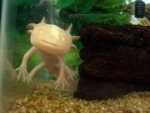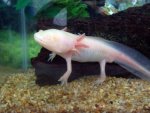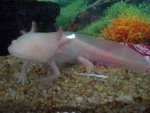So after my last substrate/pH fiasco, I'm extremely paranoid about getting an appropriate substrate for Sushi. I had initially decided upon sand, but after visiting Ace, Walmart, and a string of similar stores, I couldn't find any play sand. Even an online search on the Ace and Walmart websites only got me as close as sand boxes...I did a google search of 'silica sand' but then found myself suspicious of every product I found.
A few days ago I went hopping from pet shop to pet shop looking for something that might be suitable. At one particular store I found some really small gravel. I don't know the exact size (the bag didn't say) but I measured a few to be about 3 millimeters.
I've attached a few pics (assuming I did it right :uhoh and was hoping you experts out there could tell me if this gravel is too big? I'm afraid it still might be. So far he's acting normally, eating anything and everything I throw at him...and I want him to stay that way. Could this gravel be a problem?
and was hoping you experts out there could tell me if this gravel is too big? I'm afraid it still might be. So far he's acting normally, eating anything and everything I throw at him...and I want him to stay that way. Could this gravel be a problem?
And just to update: after a week of 20% water changes every other day, the pH in Sushi's tank has dropped from 8.6 to 8.4 (yay!). So hopefully a few more weeks of regular water changes will get his pH to where it needs to be.
I think that's it. Please let me know what y'all think of this gravel.
P.S. Isn't my guy just absolutely precious??
A few days ago I went hopping from pet shop to pet shop looking for something that might be suitable. At one particular store I found some really small gravel. I don't know the exact size (the bag didn't say) but I measured a few to be about 3 millimeters.
I've attached a few pics (assuming I did it right :uhoh
And just to update: after a week of 20% water changes every other day, the pH in Sushi's tank has dropped from 8.6 to 8.4 (yay!). So hopefully a few more weeks of regular water changes will get his pH to where it needs to be.
I think that's it. Please let me know what y'all think of this gravel.
P.S. Isn't my guy just absolutely precious??





